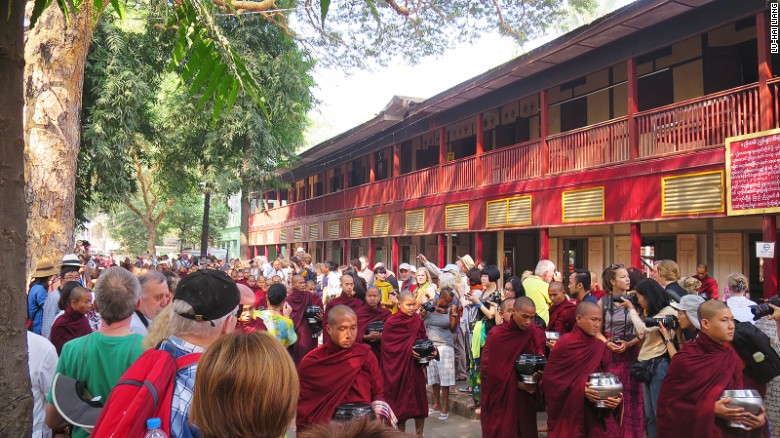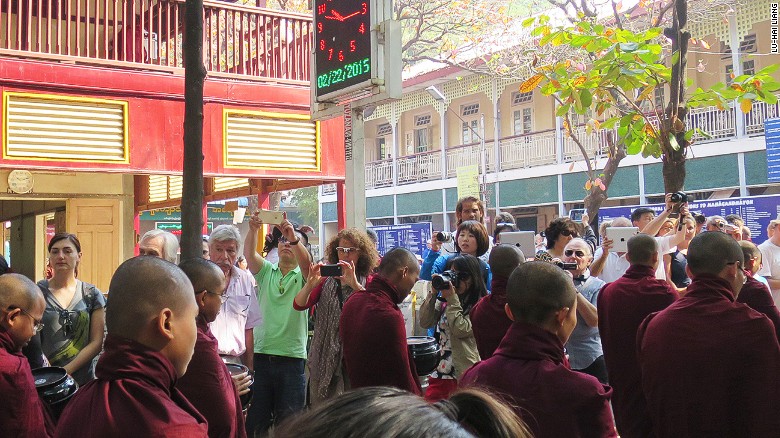Myanmar (CNN)We arrive at the monastery via a pickup truck that doubles as a bus in Amarapura township of Mandalay, Myanmar's second city, for an unusual sightseeing activity.
I actually didn't know of the existence of the monastery here until I overheard a group of fellow travelers talking about the place over breakfast.
They described it as a place you went to, ahem, watch the monks eating lunch in the morning.
I'm pleasantly surprised when we arrive.
The Mahagandhayon Monastic Institution is airy and tranquil with beautiful wooden buildings, arrayed like courtyard houses, set away from the main road.
As we move further into the monastery, others tourists and visitors become more noticeable.
The monks walk around in their rouge robes, seemingly oblivious to our presence, although I do detect a slight hint of ambivalence.
Then the "show" starts.

'Tourist paparazzi'
The monks line up along the street, clutching what look like urns -- these are actually containers for food.
The tourists snap away, myself included.
Snap, snap, click, click.
Told not to get in the way of the procession of monks, bystanders crowd the sidewalks, elbowing and pushing to get the best shot.
As the monks start walking, a frenzy of flashes from cameras raised aloft becomes audible.
I notice a slight reluctance among some visitors -- a few keep their hands off their cameras, their heads slightly lowered, as if wanting to keep their dignity by differentiating themselves from the tourist paparazzi.
A German voices doubts to his tour guide about how the "spectacle" seems intrusive and insensitive.
His tour guide says the monks have gotten used to the commotion, the way dogs are trained to certain behaviors.
The comment isn't derogatory, but rather explanatory.
Another visitor on a blog says: "It is actually embarrassing, as if we were watching animals being fed."
After the monks have eaten, the tourists dissipate and the monastery becomes a quiet sanctuary again.
The whole event is odd.
Is this an organic local ritual that's grown into a full-blown attraction?
Or a monastery opening itself up for the promise of tourist dollars through a contrived spectacle?
I decide to return the following day to find out.
Returning to the monastery
Arriving in the afternoon allows me to see the monastery in another light.
Nary a tourist can be found -- the atmosphere is serene.
Located near the scenic U-Bein Bridge, reportedly the world's longest teak footbridge, the monastery is sometimes known as the Maha Ganayon Kyaung.
Founded in 1914, the complex is home to more than 1,500 monks.
Visitors can walk the grounds freely and even attend talks and lectures.
As I sit down on a wooden platform, scribbling in my notebook, a monk approaches to ask what I'm doing.
His name is Ashin Pannadhaya, 26 years old.
He's lived in the monastery for six years.
I ask what the monks think of the tourists.
I'm expecting Buddhist mildness but his reply is blunt.
"I feel disturbed when I see unexpected trouble with the tourists," says Pannadhaya, using the English he's been studying.
"Some tourists very nice, some very bad. They take photo crazily and extremely."
"Lunchtime very private time," he adds. "They take photos, we very disturbed."
The monks wake up at 4 a.m. every day, have breakfast at 5 a.m. and begin lessons at 6 a.m.
Lunchtime is 10:15 a.m. And then they're forbidden from eating from noon until breakfast the next day.
Another monk joins us, Ashin Zavana, 22 years old.
He says it gives him a shameful feeling to be photographed during his lunch hour.
Surge in tourism
Myanmar has been enjoying a well-documented surge in tourism in recent years.
With an estimated 300,000 to 500,000 monks among a population of 53 million people, Myanmar's Buddhist culture is one of the biggest draws for visitors.
Temple and monastery visits are popular photo ops.
The appearance of tourists affects the monks' daily life, says Pannadhaya, especially the groups that come to see them eat.
He says the monastery's newfound popularity is unexpected and not initiated by the monastery.
And tourism may not necessarily be helping the monastery, as some may think.
Pannadhaya explains that the monastery relies on donations -- currently, most of those come from local devotees.
Tourists don't usually donate to the temple after visiting.
Advice for visitors
Mahagandhayon Monastic Institution is open to public.
To avoid the crowds, the best time to visit is in the afternoon.
It's also the time when spontaneous conversation is most likely to happen.
The information center can help you make a donation to the monastery. Receipts for donations are available.
Mahagandhayon Monastic Institution, 80 meters west of U-Bein Bridge, Amarapura, Mandalay, Myanmar; no entrance fee

No comments:
Post a Comment